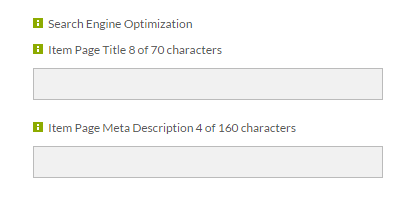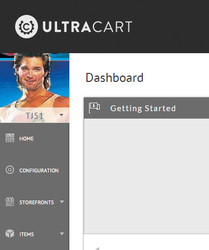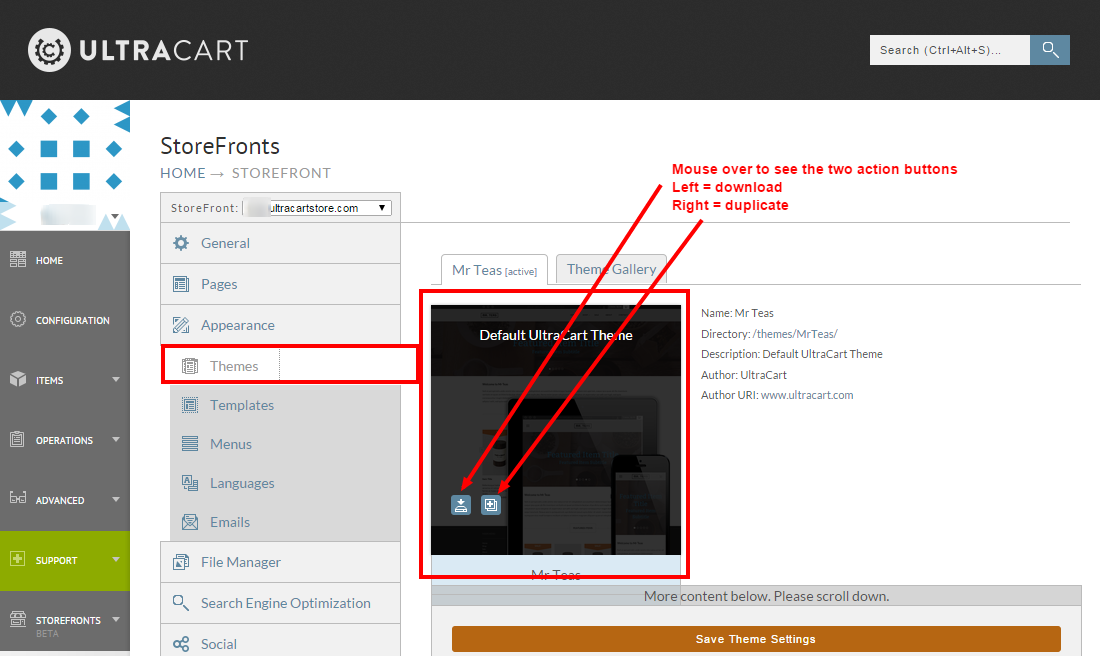StoreFront FAQ
Loyd James (Unlicensed)
Perry Tew
Click on a category to reveal frequently asked questions. Click on a FAQ to reveal the answer.
Yes, with the StoreFront system almost everything is unified into the file system. Everything that you can see under the File Manager tab in the web interface is available to you with FTP. It’s not uncommon for developers to use external development tools to write their code, compile contents with tools like Grunt, and then have it automatically uploaded via FTP.
The current StoreFront template is implemented as a series of velocity templates that provide the same functionality as the single and multi-page checkouts that the existing UltraCart platforms has. The difference being that they are completely responsive. If you’re comfortable with the stock checkout flows then you can get away with minor modifications to the templates. We recommend that you perform the majority of your customization through CSS to make version upgrades easier. If you need a customized checkout flow then you can still use the REST API to build that within the StoreFront just like you have in the catalog system. Future templates that we publish may choose to use the REST API instead of the Velocity templates, but you’ve got to pick and choose your technology battles carefully. For this initial release the best bet what was get a completely responsive checkout experience with Velocity working.
Yes, some themes, such as Trial, use the REST Checkout API to implement the checkout process. Other themes like Woodland and Fashion use the REST Checkout API to make additional functionality, like the cart snapshot, available.
Yes
This is all done under the Pages tab of StoreFronts.
If you’re an existing catalog user, you can think of StoreFronts as catalog 2.0 on steroids. The velocity templates will look familiar to you within StoreFronts. We’ve radically simplified things with StoreFronts by making almost everything a file on the file system, allowing themes within a StoreFront to make development and maintenance easier, and using meta data from the templates to drive the user interface that the merchant interacts with. Gone are the days of the end user having to read through templates to know what they should name an attribute or piece of multimedia. Beyond that we’ve also implemented a very functional and robust responsive stock template. Responsive websites that are friendly for every type of computing device are the future and we believe a good starting point is critical for merchants.
The Customer Login Section is based on the options available in the My Account and Customer Profile Areas of UltraCart -
http://docs.ultracart.com/display/ucdoc/My+Account+Customer+Portal
http://docs.ultracart.com/display/ucdoc/Customer+Profiles
Yes, they can be made available for your users whether you are using StoreFronts or not. The stock theme for StoreFronts though has the MyAccount functionality woven completely through it.
Yes, the MyAccount portal provides customers the ability to manage their recurring orders. You can decide whether or not you want to make this functionality available to them on your Customer Profile Settings.
Just like the legacy catalog, a StoreFront can have a few additional host name aliases. The templates have integrated support for canonical so that search engines don’t penalize you for having the exact sample content on multiple sites.
Our initial theme, Mr Teas is compatible all the way back to IE8. At this point in time though, that browser is no longer supported by Microsoft and receiving security updates.
If you mean fields for the database, then yes. You can associate both options and attributes to an item using the item editor and the fields will then show up on the item page.
Yes, we implement a WYSIWYG editor in most locations of StoreFronts.
Sure, Items must exist in your UltraCart account first, then when you are ready for them to move out onto your storefront, you can simply select them in the Item Assignment area. The new StoreFront admin panel is integrated with the upgraded item editor to make adding items simple. Under the admin panel click Page -> New Item. This will open the item editor in a new window with the StoreFront page already assigned. The new item editor allows you to handle all critical aspects of item configuration on the first tab (including multimedia and inventory controls).
Yes, you can edit the portion of the URL that is typically the item ID to another more SEO friendly string.
Our themes are coded to handle options and variations on the item pages. There is a theme setting that controls whether options are displayed on the item page before it's added to the cart.
The multimedia on the pages -> content is specific to the group page within the storefront. The item editor still supports video multimedia types like it always has, but the stock theme does not currently support video within it’s gallery view. Direct video support in the stock template may be something that is added later, but could be something implemented via professional services if it’s critical to a merchant. Remember that everything in the template is responsive so whatever functionality that is implemented in the template has to work across all the major mobile, tablet, and desktop platforms.
Yes, we make provisions for adding links to StoreFront pages, system pages (like view cart), and external pages (like your blog).
Themes ship with multiple preset color schemes available. On the Themes tab there is a “Theme Presets” field which contains three different professionally selected color palettes.
So, in typical PHP-based CMS, site structure/hierarchy are basically virtual—in StoreFronts everything actually exists?
The checkout is functionally similar to the existing single page and multiple page checkouts. We've made everything completely responsive, updated all the UI elements, and everything is jQuery based. We will go further into the checkout and customization during the development webinars.
The Upsell After pages will follow the same look and feel as your StoreFronts theme.
Yes, you can make slides that point to anywhere on your site or even external sites.
Use the preset drop down in the Theme area to go back to the default.
The recycle BIN located in the file manager goes back 30 days.
No, but each StoreFront encompasses all of the functionality that screen branding themes do for the legacy checkout including conversion and tracking. If you're running multiple screen branding themes right now, you can run multiple StoreFronts to replace them.
The price cannot be changed between the two storefronts (since its pulling the single defined cost from the item record), so you'd need to create two separate accounts and then links them together (see Linking Multiple Accounts)
Setting up and linking accounts is no different with StoreFronts. - Linking Multiple Accounts
All of our themes have an option for "Checkout Only Mode".
Our themes are completely responsive. Responsive websites, ones that can present all content to a user regardless of screen size, is the desired presentation type by Google. Having a completely responsive website not only increases your search rank, but also makes it easier for customers to purchase. As of 2016, the average website has 40% of their traffic coming from phones and tablets.
Yes. Once an item is added to the storefronts, the item editor will have a section that appears below the "Assignments" section, title "Search Engine Optimization" with two configuration fields: "Item Page Title" & "Item Page Meta Description"

StoreFronts includes all of the same integrated tracking capabilities of our legacy screen branding themes, plus it adds support for more advanced tracking events on Bing, FaceBook and Google.
If you do not see StoreFronts listed on your left hand menu, you may still be using the older UltraCart UI. If your screen does not look like this, then click on the upgrade banner shown on your dashboard.

Navigate to the "Themes" tab of the Storefronts mennu, then mouse over the image representing the active theme and you'll see the image change to show you two buttons. The left button is the "download" theme button (which is in effect the "backup" option.) The right button is the "duplicate" theme button.

We have not published any changes to the pricing of the platform at this time.
Right now there is no particular limitation, but we don’t recommend A/B testing between two StoreFronts. A better approach would be to use something like Google Optimizer within a single StoreFront to optimize a particular portion of content.
Most themes implement the standard single page and multi-page checkouts. The Trial theme provides a more advanced REST Checkout API based two page trial experience.
See our guide on using StoreFronts for "Checkout Only"
Yes, in the File Manager there is a way to see your changes and then revert to an earlier time in your version history.
Yes, the themes support an integrated blog module.
If you are interested in building a one off custom theme we recommend starting with one of the freely available themes. If you have further interest in developing themes to sell in our theme gallery, please contact support@ultracart.com and request permission to our GitHub repositories. You can fork our GitHub projects and start building off a solid foundation without having to reinvent the entire wheel. Our GitHub repositories will be publicly visible in a few months.
There is not a market place initially, but we have plans for one. The current stock theme will serve as a good starting place for consultants to customize for their clients. It’s amazing what some CSS tweaks and color scheme selection can do for a site’s look and feel.
StoreFronts is not a word press plugin, but you can use StoreFronts in Checkout Only Mode and embed buy links into your Wordpress site.
Each theme has a defined look and feel. You can modify the colors, CSS or even the templates themselves to match your external site. The amount of changes necessary depends upon the template you're using on your Wordpress site.